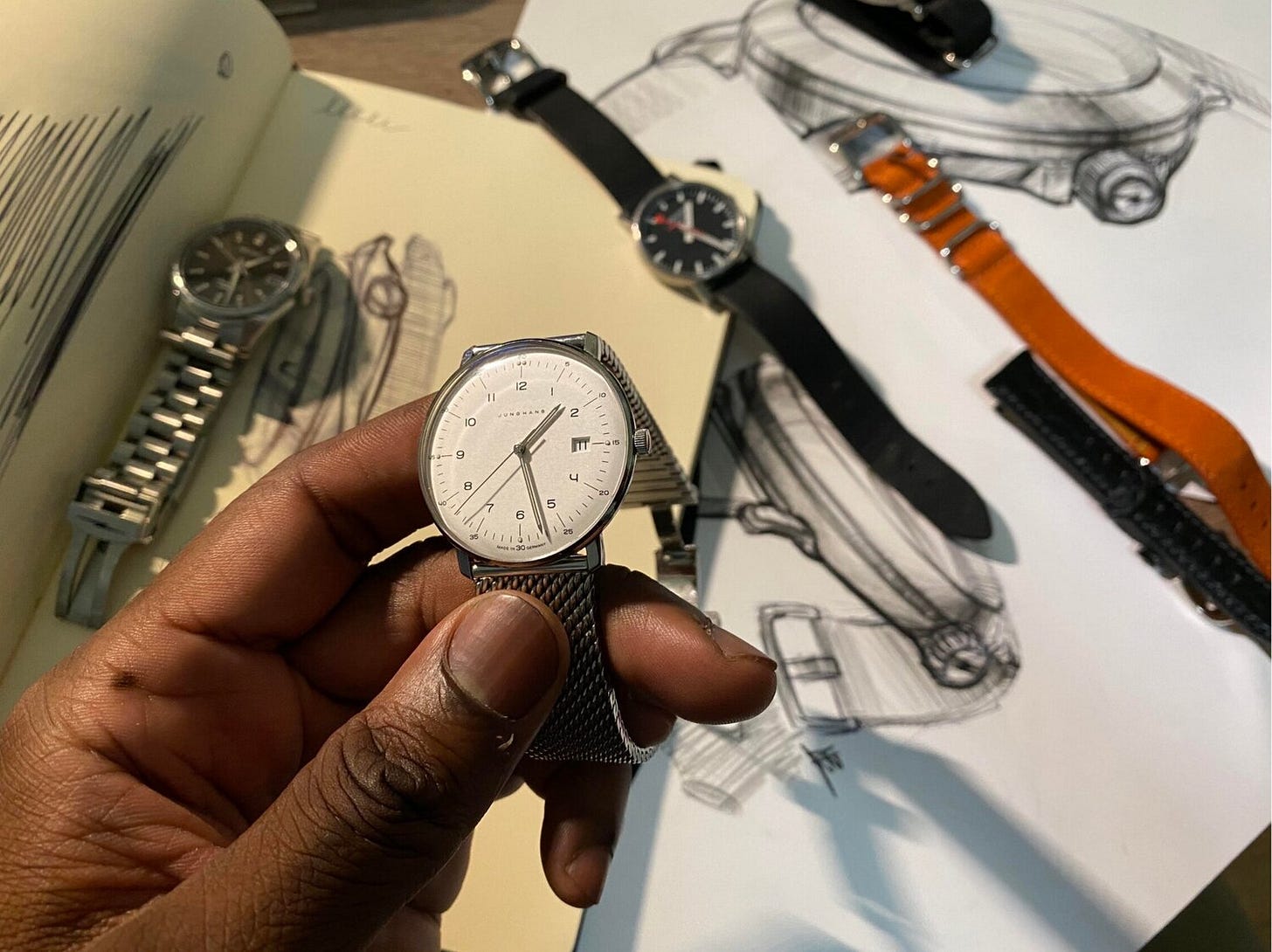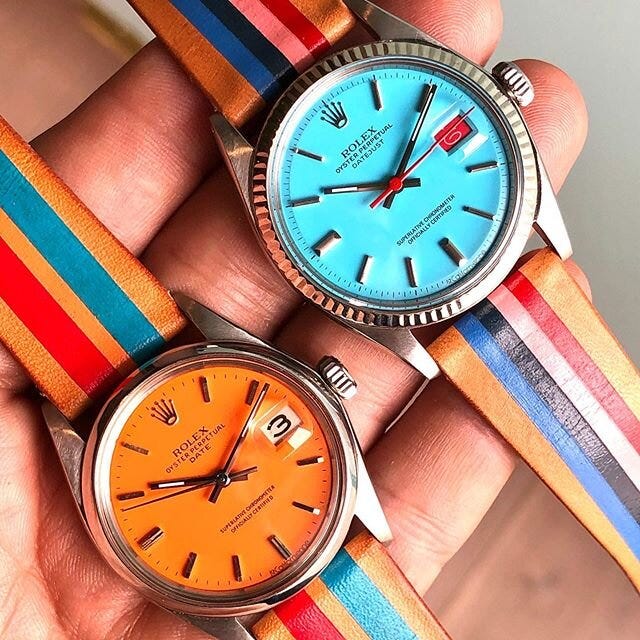Balancing Art and Design with a Shinola Watch Designer
Rolex wins its lawsuit against La Californienne; auctions, auctions, auctions
Why everyone should own a quartz watch; Rolex wins its lawsuit against La Californienne; auctions, auctions, auctions
Interview: Designer Naheem Browne
As Shinola’s first watch design intern, Naheem Browne has a deep appreciation for watch design: From a Mondaine Swiss railway watch to F.P. Journe, he takes inspiration from every piece he comes across. However, with an education in fine arts, he’s also attuned to finding the beauty all around him and striking a balance between art and function.
Naheem is graduating from the College for Creative Studies in Detroit this December. After finishing his one-year position on Shinola’s watch design team, he’s now at Ford designing cars. I caught up with the young designer to talk about designing cars and watches, balancing beauty and technicality, and why everyone should own a quartz watch.

Q: Let’s start with an introduction to yourself and your background. How did you get into design?
I’ve always been an artist and been in artistic fields. My father was a painter and my mom enjoyed having art around the house. We had a nice combination of what the world really was — beautiful pieces from the East and West. It taught me that beauty comes from everywhere. That ignited my spark in art.
I originally went to college as a fine artist — I didn’t even know design was a thing. I found an aftermarket auto-tuning shop, and I’d just go there and sketch cars. One of the customers came in for a detailing and told me that I could have a career as a car designer. I thought it was a joke, but eventually discovered it’s a real thing and I spent hours on the internet learning about car design, industrial design. For the next three semesters I continued taking as many art classes as possible, going into New York City to meet people, really immersing myself in all aspects of art.
Then, I came to CCS [College of Creative Studies] and moved to Detroit, that’s when I started my career in design and immersing myself in the design world. So, I’m trained as a car designer. In New York, I took some things for granted — being around great designers, architecture — soaking all of that in. When I came to Detroit I started to realize how heavy those influences are. No matter what people take in of their surroundings, if you’re surrounded by beautiful things it’s going to impact you. For example, if you have a watch strapped to your wrist and start to think about the artistry, the engineering, you’re going to think to yourself “whoa this is really cool” and it’s going to impact the way you see things.
What was your time as a watch designer at Shinola like?
I’ve always been interested in Shinola: Their factory building in Detroit is shared with a dorm at CCS. There’s an elevator that would open onto the 5th floor, and you’d see ‘Shinola’ printed on a glass wall and get a big whiff of leather. That was my first taste of wondering ‘what is that, and what are they doing with watches?’
I went on a tour and went to the design department, and over the next year and a half, I built up my portfolio. I was their first watch design intern, so I was very honored by that.
Immediately, it felt like I was at home. I was among other watch nerds. We weren’t just designers, but watch nerds and designers. Being at Shinola was very eye opening. You can always admire a watch from afar, but really breaking a watch apart gives you a whole new appreciation for it. For example, seeing all that goes into making just a handset, as well as the dedicated time and back-and-forth with suppliers to produce that handset brings a new appreciation to it.
I honestly don’t think that [Shinola] gets enough credit in the watch community. You have a company kickstarting an industry in a country where there hasn’t been one, and I feel as if enthusiasts turn a blind eye because it’s not made on the side of a mountain in the Swiss Alps. Making a watch isn’t easy, and they do a great job of staying true to themselves as well as paying attention to the community at large. For me, being able to design products around all of the hardworking people there was an experience I’ll always be grateful for. Automatic or quartz, they’re making products that make people happy and have value … isn’t that why we all got into and enjoy watches in the first place?
What do you look for in the design of a watch?
I don’t look for anything other than a feeling. Designer or not, everyone has a gut, visceral feeling, and then you ask yourself ‘what is that feeling?’ It’s the feeling that this is a beautiful thing. Then, you break down that feeling as to why the watch is beautiful to you.
I remember my first moment with that feeling: my brother had a Mondaine 35mm Swiss railway watch — black dial, white hands and indices. Super sleek and minimal. I saw it and thought ‘what is that?’ — I’d never seen anything like it before. From there, you look at design language, company ethics, history. It can’t just be ‘we make this’, but why do you make this, who is it benefitting, and what are you doing besides just selling things — where do you invest your time and money?
As a car and watch designer, how do you see the designs of these two objects influencing each other?
We’re all super insane about details. We’ll see a handset and grab a macro lens so we can look at it up close.
With cars it’s the same once you get under the hood. There are so many things that no one will see or notice except you, but we still obsess about them.
To have something you drive or on your wrist that represents who you are — having that connection with an object — it makes [car and watch enthusiasts] the same.
Of course, you could just look at your phone and drive a Honda Civic — not to hate on Civics, I love Civics! — but that’s not what it’s about. It’s the love affair we have with these objects, it’s their story and how it aligns with our story.
Personally, what watches do you like?
The Mondaine Swiss railway watch is the watch that inspired me to become a watch designer and an enthusiast. I’ve also got a Braun and a Max Bill. My pieces are centered around my design taste and style. I don’t want to say minimal because that word is so cliche, but it’s just things that don’t have any fuss. Honest pieces.
I’m also a Cartier Tank fan, so I’ve got a [square] Rotary as a placeholder. I love the beauty and essence of a Tank-style watch. If you’re wearing a Tank, you’re showing you’re not afraid of stepping out and being seen as different.
I’ve also got an old Elgin pocket watch from 1922. I was in New Jersey and found it searching for old watches. I saw it and thought ‘what am I going to do with this?’ but ended up buying it anyway. It’s so beautiful — it’s got a beautifully patinated off-white dial and blued hands. Even if I don’t wear it, it still feels special, so I just went with it.
[Ed. note: Naheem went on to show off his black dial SARB033, fitted on a Shinola divers’ bracelet, and his three Shinola watches: a Bedrock Chronograph, titanium Runwell Small Seconds, and a concept piece he helped design that we won’t say any more about for now.]
Professionally, what watches influence your design?
I regard Grand Seiko very highly for the level of finishing, detail and pure craftsmanship for such an insane price — it’s astonishing. FP Journe too: Now, you can’t even buy them, but no one even knew about him starting out. It brings a new era to watchmaking. It’s Bauhaus meets Art Nouveau — that beautiful blend of simplicity and hitting the right details. It shows you don’t need to throw a million things on your dials to make them work. Of course, Cartier as well: They’ve got a great history and the way they re-imagine those classics is really exciting. Nomos is also a really big influence for me; I absolutely love their Club Sport.
Among the holy trinity of watchmakers, Vacheron Constantin seems to step out of the box the most. Take something as small as the bracelet on the Overseas: it’s functional because you can just take it on and off, but it’s instantly recognizable as well.
But I’m also always open to learning and discovering new brands. There are so many brands and people — John Goldberger, Wei Koh, Ben Clymer — that show me things and I’m always learning about watches and brands that were released 50-60 years ago. Most brands have something to offer in terms of looking for an aesthetic or something I can learn from them.
How does your fine arts background influence how you look at watches?
Design is human-centered and focused on making peoples’ lives better. I strive to find the balance between art and function. I always like to bring art to whatever I do. There are so many people I look up to and find inspiration from, designers like Ini Archibong, Marc Newsom, and Max Bill. Art is everywhere, and I feel like having my background in art has trained me to see the art around us. But everything is also design. Finding that balance between beauty and technicality is what I strive to search for in beautiful objects.
What’s next for you?
I just picked up film photography. I’m shooting 35mm film, before that I was shooting digital on my iPhone only. I love the challenge of taking something that’s not supposed to be and turning it into that thing.
As far as my career goes: Every project that I finish with opens my eyes to something else, and I’m in a constant state of learning.
Anything else you want to talk about?
I personally think every watch enthusiast should own a quartz watch. You can have a vast collection, but having something that grounds you and your perspective will open you to so many other things. It can be a Swatch, Timex Ironman, whatever, but everyone needs to have a piece in their collection that grounds them.
You can follow Naheem on Instagram @nbrownedesign.
Rolex wins trademark lawsuit against La Californienne
On a basic level, intellectual property protections (trademarks, copyrights, patents) exist to incentivize innovation. In fact, it’s in our very Constitution — “to promote the progress of science and useful arts.” Promoting this progress is a push and pull between the past and the future. It requires balancing two competing interests: (1) protecting IP that’s already been developed and (2) encouraging future innovators to build and improve upon what already exists.
La Californienne, the maker of colorful, customized vintage Rolex watches, has reached a settlement with Rolex to end the lawsuit Rolex filed against it last year. The Central District of California entered a final judgment in favor of Rolex for claims of trademark counterfeiting, trademark infringement and false designation of origin.
As part of the settlement and final judgment, La Californienne is permanently enjoined (prohibited) from:
Using or reproducing any Rolex trademarks, including on its website
Engaging in any conduct likely to cause confusion or dilute Rolex’s trademarks
Using a description including words or symbols representing its products as Rolex watches
Providing any warranty or services on already-sold watches that bear Rolex’s name or logo
If it’s any consolation, when asked, La Californienne can tell customers that its watches were formerly vintage Rolex watches, now modified. La Californienne had 10 days after the judgment was entered on May 28 to scrub from its website and associated social media accounts all mentions of Rolex.
Tl;dr: La Californienne will be able to continue using vintage Rolex watches, but it will no longer be able to use Rolex’s trademark name or logo in any way — not on the watches, not in its advertising.
As of this writing, La Californienne’s website is a simple landing page, and all images of Rolex watches have been deleted from its Instagram account. Now, photos of colorful, customized Cartier watches remain.
As a reminder, La Californienne was in the business of taking vintage Rolex timepieces, sprucing them up and adding some color, and then reselling them through their network of high-end retailers. As the court found, the company buys an old Rolex then strips the original dial surface, removing the Rolex trademarks (e.g. the Rolex name, crown, and model name), paints the watch a colorful, millennial-favored hue, and then re-applies the Rolex trademarks removed from the original dial while also painting “laCalifornienne” on the dial, also replacing components like the crystal and band.
After this judgment, they’ll be able to continue much of this process, up to the part where they would re-apply the Rolex name and logo after refinishing the dial. The judgment makes no mention of any monetary payment, providing only that both parties will bear their own attorney’s fees.
As for the future of La Californienne, it seems the company is still selling Cartier watches, using the “Cartier” trademark both on the watch and in its advertising. The Richemont-owned brand has not initiated any litigation against La Californienne yet, but stay tuned.
I’m a bit conflicted on how I feel about the case’s outcome. On first principles, does preventing La Californienne from using Rolex’s trademarks stall the “promotion of progress” entirely? Rolex went after a company that created a popular product that Rolex would never otherwise create, so what’s the problem? On the other hand, take a look at the watches below: Even if there’s no Rolex crown or name, you’ll probably still recognize them as Rolex. La Californienne using the Rolex name is just gratuitous, even “free-riding”. Perhaps that’s the irony: Rolex’s designs are so ubiquitous that, even without the use of its trademarks, it’s still clear what La Californienne’s products are.

Auctions
Phillips: Geneva Watch Auction XI
There are 200+ lots in the Phillips Geneva Watch Auction XI at the end of June. The selection is worthy of a more in-depth preview, but to highlight just a few favorites in the under-$10k category:
A Tank Asymetrique in yellow gold, part of a limited edition of 300 from 1996.
Zenith AH271: I’ve discussed my love of the Zenith A271 with a slate grey dial before, and Phillips is offering what looks to be a very sharp example. Powered by the Zenith caliber 146 (nee Universal Geneve 285), it’s just a solid manually wind chronograph with one of my favorite dials around.
Role Tru-Beat reference 6556: Not only is the Tru-Beat — Rolex’s version of a dead-beat seconds — one of my favorite Rolex models, this example has a cool story. It was originally purchased by a Rolex watchmaker for training, who eventually gave it to his aunt, a British Red Cross medical worker. It’s a fitting gift: the dead-beat seconds mechanism is designed to permit more accurate readings of patients’ pulses.
Bob’s Watches: Fresh Finds Auction
Meanwhile, Bob’s Watches is running an online auction with 16 Rolex “fresh finds,” including the Daytona Paul Newman reference 6241 that a woman found in her couch. The auction ends June 15, with the ref. 6241 currently sitting at $185k (no buyer’s premium!).
Things Happen
🤳 Just hold your watch next to the screen: NYT on virtual watch meetups. 👑 Nick Foulkes on the eternal appeal of Cartier. 𝑄 Todd Snyder and Timex team for the latest Timex Q. ❺ The new no-bezel Seiko 5 is starting to pop up on websites, but quickly selling out — still some available at END Clothing.
In Chicago: 8 road-trips for the corona era
Thanks for reading!
-Tony
Tap the heart above to like this email, or leave a comment:




